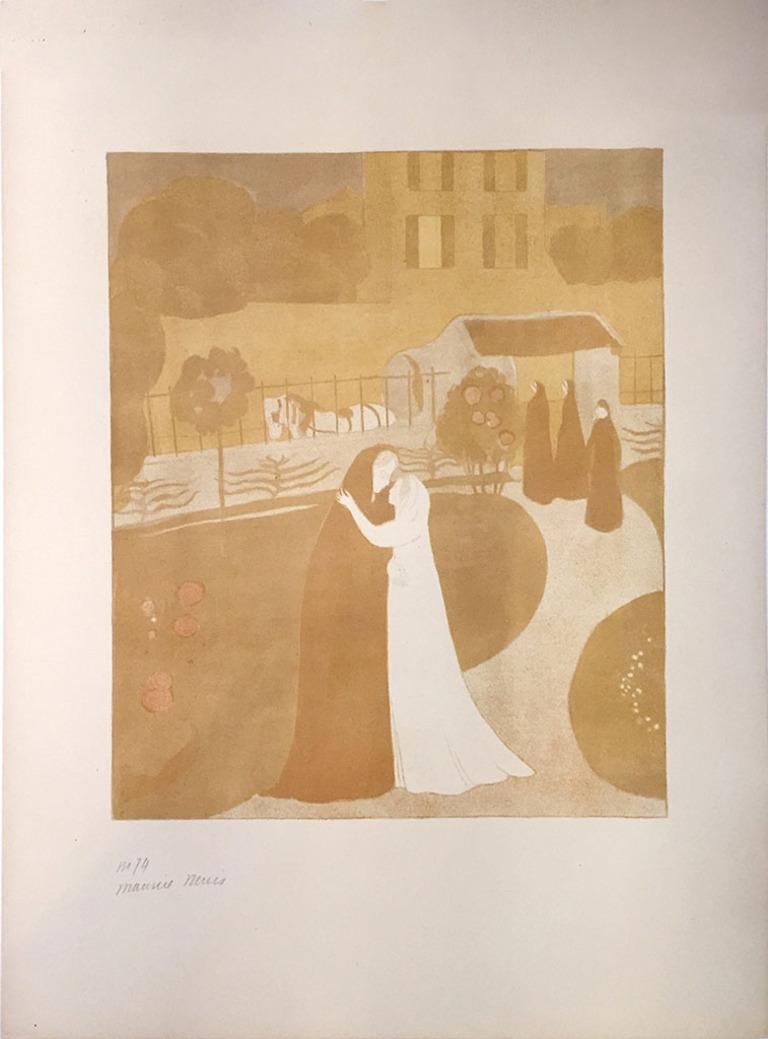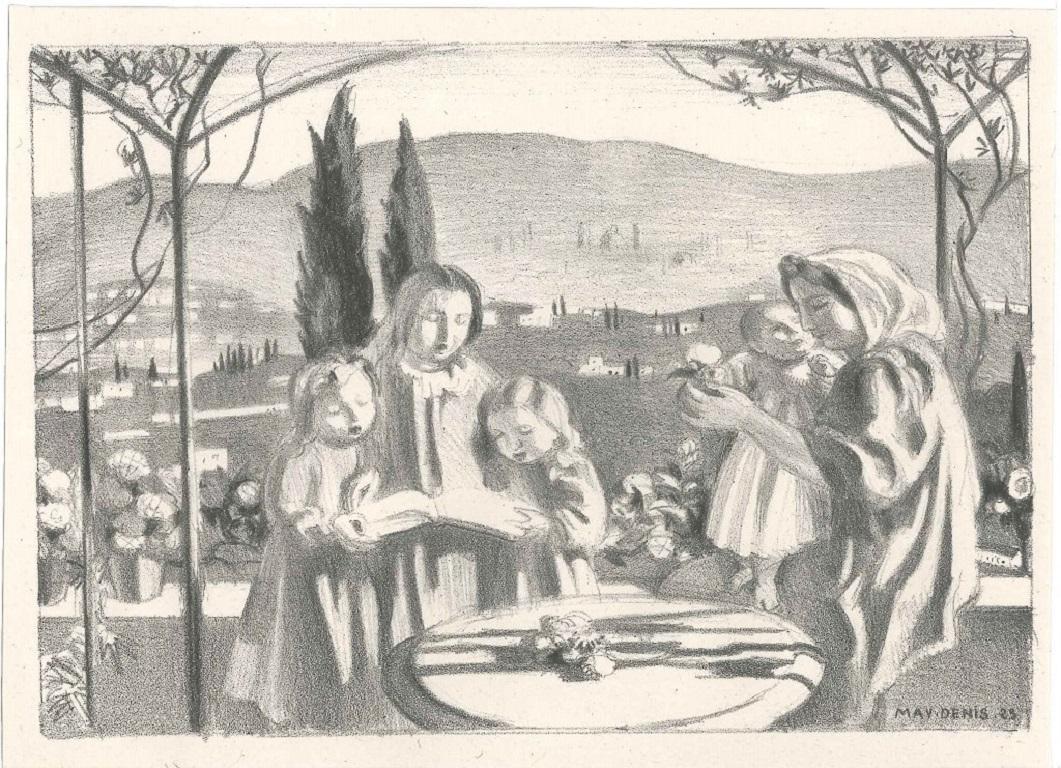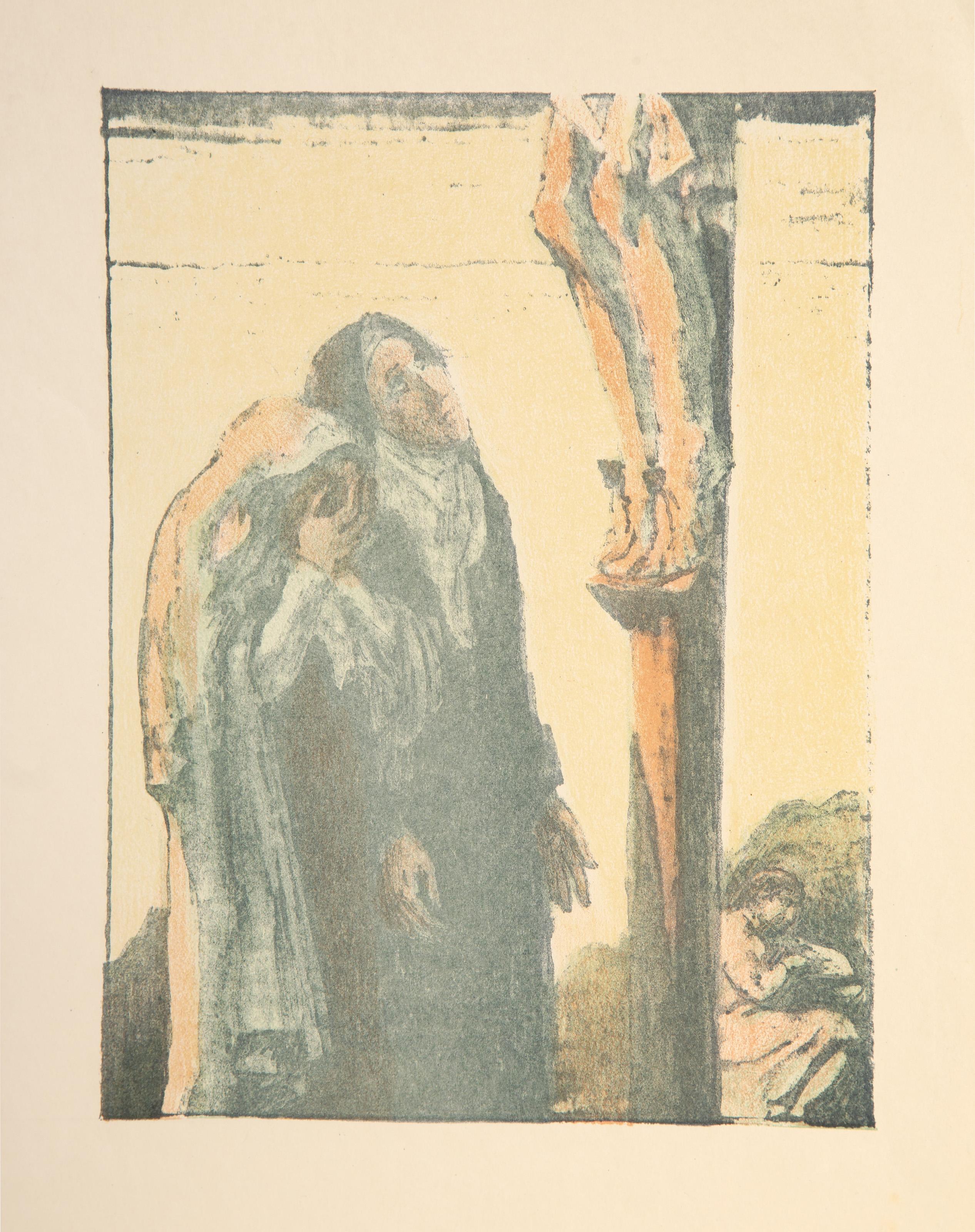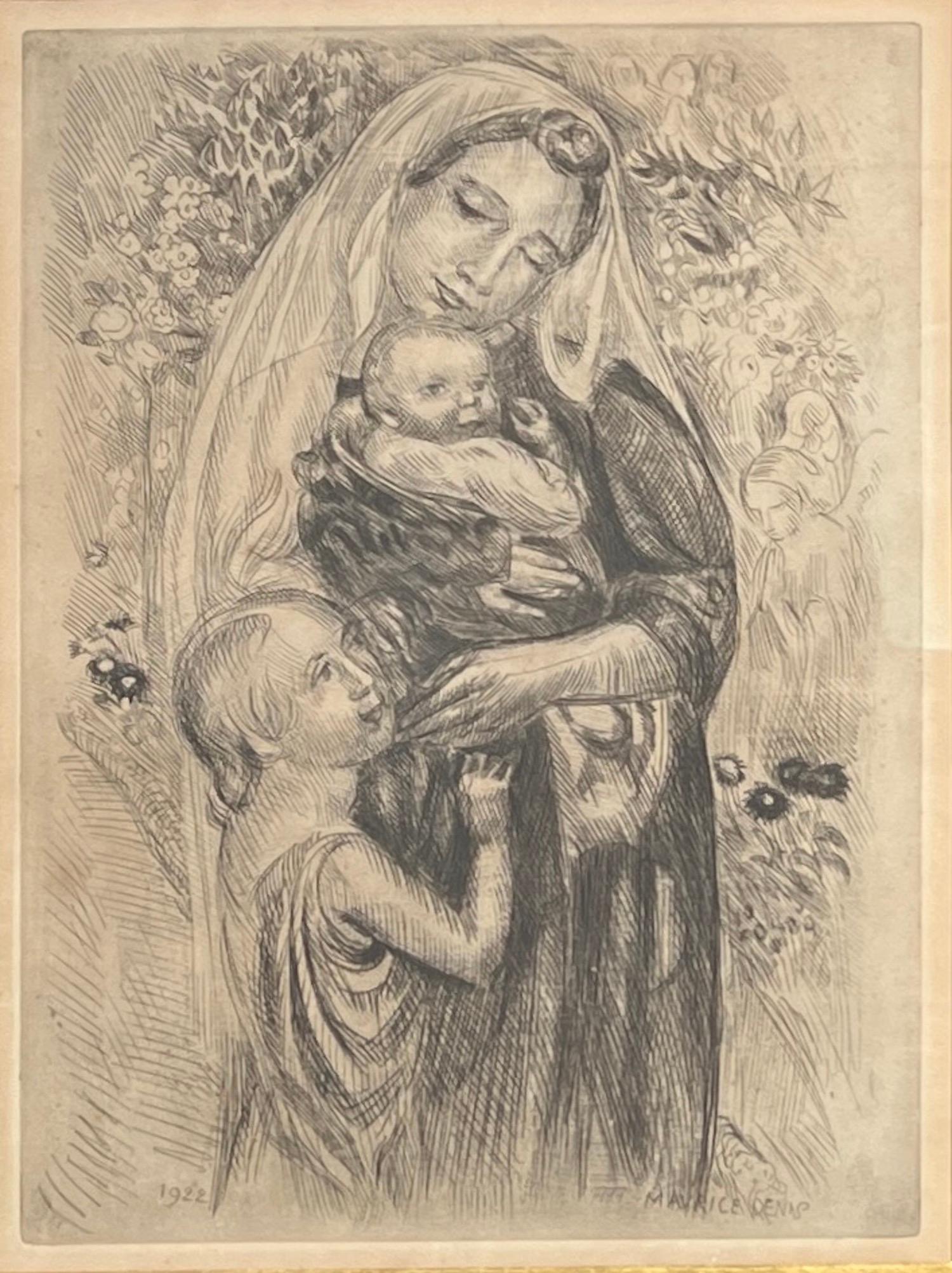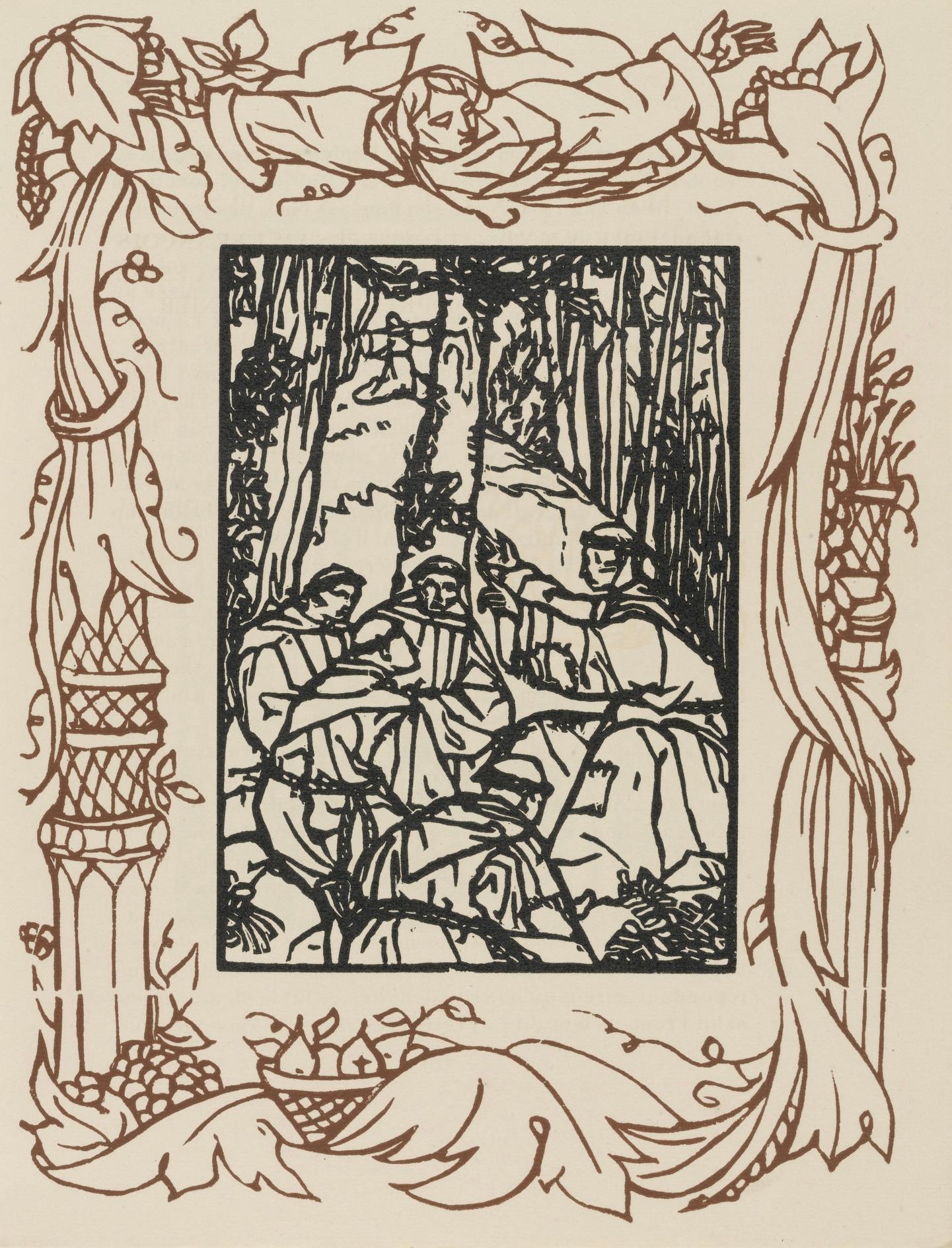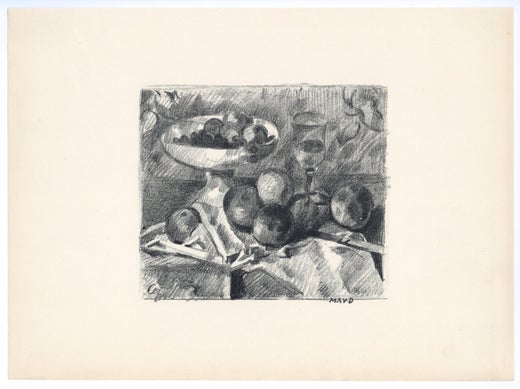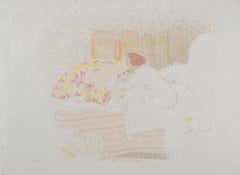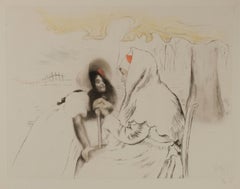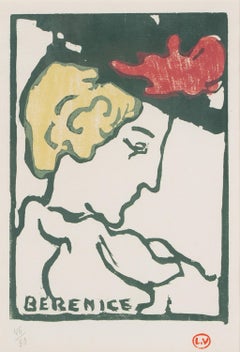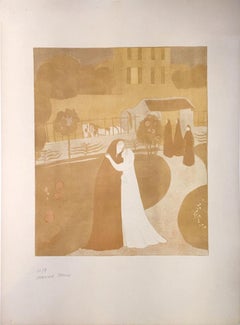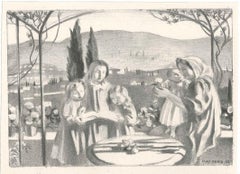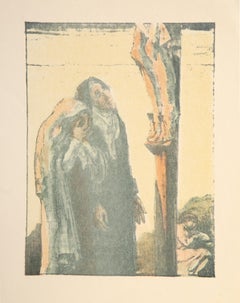Items Similar to Les Pelerins d'Emmaus (The Pilgrims of Emmaus)
Want more images or videos?
Request additional images or videos from the seller
1 of 12
Maurice DenisLes Pelerins d'Emmaus (The Pilgrims of Emmaus)1895
1895
$6,000
£4,569.55
€5,260.17
CA$8,598.48
A$9,407.89
CHF 4,854.45
MX$112,658.48
NOK 61,629.48
SEK 57,740.88
DKK 39,282.57
About the Item
Les Pelerins d'Emmaus (The Pilgrims of Emmaus)
After a 1894 painting by Denis in the Van Gogh Museum (see photo)
Color lithograph, 1895
Signed in pencil (see photo)
Initialed and dated in the stone (see photo)
Edition: 100 (6/100, No. 6)
Reference: Cailler 84
This color lithograph is Denis's homage to Rembrandt's painting of the same title in the collection of the Louvre. Denis undoubtedly knew the Rembrandt painting.
Provenance: Sagot Heirs
Condition: Excellent
Image size: 12 x 17 7/8 inches
Maurice Denis
From Wikipedia, the free encyclopedia
Born: 25 November 1870, Granville, Manche, Normandy, France
Died 13 November 1943 (aged 72), Paris, France
Education École des Beaux-Arts, Académie Julian
Maurice Denis (French: [dəni]; 25 November 1870 – 13 November 1943) was a French painter, decorative artist and writer, who was an important figure in the transitional period between impressionism and modern art. He was associated with Les Nabis then the Symbolist movement, and then with a return to neo-classicism. His theories contributed to the foundations of cubism, fauvism, and abstract art. Following the First World War, he founded the Ateliers d'Art Sacré (Workshops of Sacred Art), decorated the interiors of churches, and worked for a revival of religious art.
Biography
Early life
Maurice Denis was born 25 November 1870, in Granville, Manche, a coastal town in the Normandy region of France. His father was of modest peasant origins; after four years in the army, he went to work at the railroad station. His mother, the daughter of a miller, worked as a seamstress. After their marriage in 1865, they moved to Saint-Germain-en-Laye in the Paris suburbs. His father was employed in the offices the administration of the Western Railroads in Paris.
Maurice was an only child. From an early age, his passions were religion and art. He began keeping a journal in 1884 at the age of thirteen. In 1885 he recorded in his journal his admiration for the colors, candle light and incense of the ceremonies at the local church. He frequented the Louvre, and admired especially the works of Fra Angelico, Raphael and Botticelli. At the age of fifteen he wrote in his journal, "Yes, I must that I become a Christian painter, that I celebrate all the miracles of Christianity, I feel that is what is needed." In 1887 he discovered a new source of inspiration, the works of Puvis de Chavannes.
Denis was accepted as a student at one of the most prestigious Paris schools, the Lycée Condorcet, where he excelled at philosophy. However, he decided to leave the school at the end of 1887 and in 1888 enrolled in Académie Julian to prepare for the entrance examination to the École des Beaux-Arts in Paris. There he studied with the painter and theorist Jules Joseph Lefebvre. He passed the entrance examination for the Beaux-Arts in July 1888, and passed another examination in November to receive his baccalaureate in philosophy.
Les Nabis
At the Académie Julian, his fellow students included Paul Sérusier and Pierre Bonnard, who had shared ideas about painting. Through Bonnard he met additional artists, including Édouard Vuillard, Paul Ranson, Ker-Xavier Roussel and Hermann-Paul. In 1890 they formed a group which they called the Nabis, taken from "Nabi"—Hebrew for "Prophet". Their philosophy was based upon the philosophy of positivism, and the writings of Auguste Compte and Hippolyte Taine. I rejected naturalism and materialism in favor of something more idealistic. Denis described it in 1909: "Art is no longer a visual sensation that we gather, like a photograph, as it were, of nature. No, it is a creation of our spirit, for which nature is only the occasion."
For his technique, Denis was first drawn toward the neoimpressionist style of Seurat, but rejected it as too scientific. In 1889, Denis was captivated by an exposition of works of Gauguin and his friends at the Cafe Volponi, on the edge of the Paris Universal Exposition of 1889. Recalling it later, Denis wrote, "What amazement, followed by what a revelation! In place of windows opening on nature, like the impressionists, these were surfaces which were solidly decorative, powerfully colorful, bordered with brutal strokes, partitioned." The work of Gauguin had an immediate effect on Denis' work. The brightly colored forms of Gauguin's Vache au-dessus du gouffre first shown in 1889, appeared in an October 1890 work by Denis, Taches du soleil sur la terrace, and later in Denis' Solitude du Christ (1918).
The Nabis drifted apart by the end of the 1880s, but their ideas influenced the later work of both Bonnard and Vuillard, as well as non-Nabi painters like Henri Matisse.
Japanism
Another influence on Denis at the time was the art of Japan. The interest of French artists in Japanese arts had begun in the 1850s, then was renewed by displays at the Paris Universal Exposition (1855) and was revived again in 1890 by a major retrospective of Japanese prints at the École des Beaux-Arts. Even before 1890 Denis had been cutting out and studying the illustrations of the catalog Japan Artistique published by Siegfried Bing. In November 1888 he had declared to his friend Émile Bernard that he wanted to move from "Giving color to (Puvis de Chavannes)" to "making a blend with Japan." His paintings in the Japanese style featured a wide format and very stylized composition and decoration, appearing like Japanese screens.
"A flat surface covered with colors assembled in a certain order"
In August 1890, Denis consolidated his new ideas and presented them in a famous essay published in the review Art et Critique. The celebrated opening line of the essay was: "Remember that a picture, before being a battle horse, a female nude or some sort of anecdote, is essentially a flat surface covered with colors assembled in a certain order." This idea was not original to Denis; the idea had been forward not long before by Hippolyte Taine in The Philosophy of Art, where Taine wrote: "A painting is a colored surface, in which the various tones and various degrees of light are placed with a certain choice; that is its intimate being." However, it was the expression of Denis which seized the attention of artists and became part of the foundation of modernism. Denis was among the first artists to insist on the flatness of the picture plane—one of the great starting points for modernism. However, as Denis explained, he did not mean that form of the painting was more important than the subject. He went on to write: "The profoundness of our emotions comes from the sufficiency of these lines and these colors to explain themselves...everything is contained in the beauty of the work." In his essay, he termed this new movement "neo-traditionalism", in opposition to the "progressism" of the neo-impressionists, led by Seurat. With the publication of this article, Denis became the best-known spokesperson for the philosophy of the Nabis, though in fact that group was very diverse and had many different opinions about art.
The next major event in the life of Denis was his meeting with Marthe Meurier in October 1890. From June 1891 they had a long romance, meticulously documented in his journal, and were married on 12 June 1893. She became an important part of his art, appearing in many pictures and also in decorative works, such painted fans, often as an idealized figure representing purity and love.
Symbolism
By the early 1890s, Denis had arrived at the artistic philosophy which guided most of his later work, and which changed very little; that the essence of art was to express love and faith, which to him were similar things. On 24 March 1895 he wrote in his journal: "Art remains a sure refuge, the hope of a reason in life from now on, and the consoling thought that little beauty manifests itself in our lives, and that we are continuing the work of Creation....Therefore the work of art has merit, inscribed in the marvelous beauty of flowers, of light, in the proportion of trees and shape of waves, and the perfection of faces; to inscribe our poor and lamentable life of suffering, of hope and of thought."
The art world was in transition in the early 1890s, with the death of Van Gogh in 1890 and of Seurat in 1891, and the first departure of Gauguin to Tahiti. The French State was gradually giving up its dominance of art through the annual salons it organized. An independent Salon had been formed in 1884 and in 1890 the official Salon broke into two parts, with the formation of the Société national des Beaux-Arts, with its own annual show. Denis showed his works in both salons, as well as the La Libre Esthétique salon in Brussels, a leading European showcase for avan-garde art. The literary movement called symbolism was launched by Jean Moréas in an article in Le Figaro in 1891. In March 1891 the critic George-Albert Dourer wrote an article for the Mercure-de-France calling Denis the leading example of "symbolism in painting". The work of Denis attracted the attention of critics and of important patrons, most notably Arthur Huc, the owner of the prominent newspaper La Dépêche de Toulouse who organized his own art salons and purchased a number of works by Denis.
Denis experimented with other art forms and with decorative art. Beginning in 1889, to illustrate an edition of the book of poems Sagesse by Paul Verlaine, Denis carved a series of seven highly stylized woodblock prints, distilling the essence of his work. His patron Huc commissioned two large decorative panels, in the form of tapestries, for his Toulouse office. Denis, like other artists of the period, also designed colorful lithograph posters with the arabesque curves of the Art Nouveau.
Beginning in 1891, shortly after his engagement, Denis made Marthe the most frequent subject of his paintings; she was depicted, in purified and idealized form, doing household tasks, taking naps, and at the dining room table. She appeared in his landscapes, and in his most ambitious works of the time, The series called The Muses, which he began in 1893, and showed at the Salon of Independents in 1893. He sold the first painting to his friend Arthur Fontaine; In 1899 The French state acquired one of the paintings, his first official recognition.
His wife played the piano, and throughout the 1890s Denis had a growing interest in the connections between music and art. He painted a portrait of her at the piano in 1890. He designed a flowing lithograph, featuring Marthe, for the cover for the sheet music of La Damoiselle élue by Claude Debussy, as well as another lithograph for the poem Pelléas et Mélisande by Maurice Maeterlinck, which Debussy transformed into an opera; and in 1894 he painted La Petit Air, based on the poem Princesse Maleine by Stéphane Mallarmé, the most prominent literary proponent of symbolism. In 1893 made a collaborative project with the writer André Gide, which combined art and literature; he provided a series of thirty lithographs to accompany a long essay by Gide, called Le Voyage d'Urien. The Lithographs did not illustrate the text, but approached the same topics from an artist's point of view.
Another topic he addressed in this period was the relationship between sacred love and profane love. The painting had three female figures, two nude and one clothed, following the model of Le Concert Champêtre and L'Amour Sacré et L'Amour Profane of Titian and Déjeuner sur l'herbe by Manet. The setting is his own garden, with the viaduct of Saint-Germain-en-Laye in the background. The nude figures represented sacred love, and he clothed figure profane love. He made another painting, this time of Marthe nude in the garden, representing both sacred and profane love in one figure.
Art Nouveau and decorative art
In the mid-1890s, with the appearance of the Art Nouveau style in Brussels and Paris, Denis began to pay greater attention to the decorative arts, though his themes of family and spirituality remained the same. Many of his new projects were commissioned by Samuel Bing, the art dealer whose gallery gave its name to Art Nouveau. His new projects included designs wallpapers, stained glass, tapestries, lamp shades, screens, and fans. But while he worked within the time period and used the materials of the Art Nouveau, his themes and style remained distinctly his own.
His most important decorative work was a series of painted panels for the office of Baron Cochin, together called The Legend of St. Hubert, painted between 1895 and 1897. It drew freely upon the Medici Chapel in Florence, and the works of Nicolas Poussin, Delacroix and Pierre Puvis de Chavannes. Cochin and his family appear in one panel, and Denis's wife Anne in another. The panels celebrated families and faith. The Archbishop of Paris celebrated a mass in the office, when the French government nationalized his residence and other church property in 1907.
He produced a small number of portraits, including an unusual portrait of Yvonne Lerolle (1897) which showed her in three different poses in the same picture.
Neo-Classicism
In January 1898 Denis made his first visit to Rome, where the works of Raphael and Michelangelo in the Vatican made a strong impression upon him. He wrote a long essay, Les Arts a Rome, declaring: "the classical aesthetic offers us at the same time a method of thinking and a method of wanting to be, a moral and at the same time a psychology...The classical tradition as a whole, by the logic of the effort and the greatness of results, is in some way parallel with the religious tradition of humanity." In the same year, the two leading figures of symbolism in art, Gustave Moreau and Puvis de Chavannes, died. On his return to Paris, Denis re-oriented his art toward neo-classicism, with clearer lines and figures. He noted in his journal in March 1898: "Think of late paintings where Christ is the central figure...Remember the large mosaics of Rome. Reconcile the employment of large-scale decorative means and the direct emotions of nature."
Denis was a great admirer of Paul Cézanne; he traveled to Cézanne's home in 1896, and wrote an article reporting Cézanne's comment: "I want to make of impressionism something solid and durable, like the art in museums." In the article, Denis described Cézanne as "the Poussin of impressionism" and called him the founder of modern neo-classicism. One of the most important works of Denis from this period is Homage to Cézanne (1900), painted following the death of his friend Paul Cézanne. In the foreground, it portrays the friends of Cézanne, several of them former Nabis; from left to right (Odilon Redon, Édouard Vuillard, the critic André Mellerio, Ambroise Vollard, Denis himself, Paul Sérusier, Paul Ranson, Ker-Xavier Roussel, Pierre Bonnard, and Denis's wife Marthe). The painting appears very somber because they are all dressed in black for mourning, but it also has a second message; the paintings displayed behind the figures and on the easel represent the transition of modern art, from works by Gauguin and Renoir on the back wall to the painting by Cézanne on the easel, which illustrated, from Denis's point of view, the transition from impressionism and symbolism toward neo-classicism.
Denis was affected by the political turmoils of the time, such as the Dreyfus affair (1894–1906) which divided French society and the art world with Émile Zola and André Gide on one side, defending Dreyfus, and Rodin, Renoir and Denis on the other. Denis was in Rome during most of the events, and it did not affect his friendship with Gide. More significant for him was the movement of the French government to reduce the power of the church, and the decision of the government to officially separate the church and state in 1905. Denis joined the nationalist and pro-Catholic Action Française in 1904, and remained a member until 1927, when the group had moved to the extreme right and was formally condemned by the Vatican.[
Until about 1906 Denis was considered in the avant-garde of Paris artists, but in that year Henri Matisse presented La Joie de Vivre with the bright and clashing colors of fauvism. In response, Denis turned increasingly toward mythology and what he termed "Christian humanism". In 1898, he had bought a small villa at the beach in Perros-Guirec in Brittany, which was then a remote and little-populated fishing village. In 1907, he used the beach there as the setting for the neoclassical Bacchus and Ariadne, brightening his colors and showing a happy family romping nude on the beach. He followed this with a series of pictures of nudes at the beach or in bucolic settings, based on mythological themes
Book design and illustration
From 1899 to 1911 Denis was also busy with graphic arts. For the publisher Vollard he made a set of twelve color lithographs titled Amour, which was an artistic but not a commercial success. He then returned to making woodblock prints, doing a black-and-white series L'Imitation de Jesus-Christ, in collaboration with the engraver Tony Beltrand, which published in 1903, then illustrations for Sagesse by the poet Paul Verlaine, published in 1911. In 1911 he began work on illustrations for Fiorette by Saint Francis of Assisi. For this project he traveled alone by bicycle through Umbria and Tuscany, making drawings. The final work, published in 1913, was filled with rich and colorful floral illustration. He also made highly decorative book designs and illustrations for Vita Nova by Dante (1907) and twenty-four illustrations for Eloa by Alfred de Vigny (1917). The last work, made during the midst of the First World War was more somber than his earlier work, largely colored in pale blues and greys.
Courtesy Wikipedia
- Creator:Maurice Denis (1870-1943, French)
- Creation Year:1895
- Dimensions:Height: 12 in (30.48 cm)Width: 17.88 in (45.42 cm)
- Medium:
- Movement & Style:
- Period:
- Condition:
- Gallery Location:Fairlawn, OH
- Reference Number:Seller: FA16331stDibs: LU14015709202
Maurice Denis
Painter, engraver and decorator, Maurice Denis. French artist, born in November 1870 in Granville in Normandy and died in November 1943. He studied at the Lycée Condorcet in Paris, then simultaneously at the École des beaux-arts and at the Académie Julien.
However, Denis did not recognize himself in the naturalist style promoted by his teachers, so he formed Les Nabis with other artists such as Paul Sérusier, Pierre Bonnard and Paul Elie Ranson. This group and artistic movement claims symbolism, partly inspired by Paul Gauguin and Émile Bernard. Denis and the Nabis have a characteristic style which consists of the application of large areas of paint and the use of radical and unusual colors. Denis is a very productive painter. He exhibited numerous works alongside those of other Symbolists and Neo-Impressionists during the 1890s. A characteristic work of this period is Spring (1897) which is now part of the permanent collection of the Met in New York. Throughout the first half of the 20th century, Denis exhibited his work regularly, both at the Salon de la Société Nationale and at the Salon des Indépendants. In 1914, he purchased and began the restoration of a 17th century priory in Saint-Germain-en-Laye near Paris. In 1980, the priory was transformed into a museum, dedicated to the works of Denis and more generally to the Nabi movement. The priory is renamed the Priory Departmental Museum. Denis' works have also been exhibited at the Montreal Museum of Fine Arts and the Walker Art Gallery in Liverpool, England.
About the Seller
5.0
Recognized Seller
These prestigious sellers are industry leaders and represent the highest echelon for item quality and design.
Platinum Seller
Premium sellers with a 4.7+ rating and 24-hour response times
Established in 1978
1stDibs seller since 2013
815 sales on 1stDibs
Typical response time: <1 hour
Associations
International Fine Print Dealers Association
- ShippingRetrieving quote...Shipping from: Fairlawn, OH
- Return Policy
Authenticity Guarantee
In the unlikely event there’s an issue with an item’s authenticity, contact us within 1 year for a full refund. DetailsMoney-Back Guarantee
If your item is not as described, is damaged in transit, or does not arrive, contact us within 7 days for a full refund. Details24-Hour Cancellation
You have a 24-hour grace period in which to reconsider your purchase, with no questions asked.Vetted Professional Sellers
Our world-class sellers must adhere to strict standards for service and quality, maintaining the integrity of our listings.Price-Match Guarantee
If you find that a seller listed the same item for a lower price elsewhere, we’ll match it.Trusted Global Delivery
Our best-in-class carrier network provides specialized shipping options worldwide, including custom delivery.More From This Seller
View AllLa Naissance d’Annette (Birth of Annette)
By Edouard Vuillard
Located in Fairlawn, OH
La Naissance d’Annette (Birth of Annette)
Color llithograph, 1899
Unsigned (as usual)
Edition: 100
Publisher: Ambrose Vollard
Printer: Auguste Clot, Paris
Condition: Excellent with f...
Category
1890s French School Figurative Prints
Materials
Lithograph
L'Aieule (The Grandmother)
By Louis Legrand
Located in Fairlawn, OH
L'Aieule (The Grandmother)
Etching and aquatint printed in colors, 1904
Signed with the red stamp of the publisher, Gustave Pellet, Lugt 1193 and numbered (see photo)
Edition: 100 (81/100)
Reference: Arwas 202 iv/IV
IFF 98
Condition: Excellent, the sheet aged as usual
Image size: 14 1/4 x 18 5/8"
Sheet size: 16 15/16 x 24 1/4"
Louis Auguste Mathieu Legrand (29 September 1863 – 1951) was a French artist, known especially for his aquatint engravings, which were sometimes erotic. He was awarded the Légion d'honneur for his work in 1906.
Life
Legrand was born in the city of Dijon in the east of France. He worked as a bank clerk before deciding to study art part-time at Dijon's Ecole des Beaux-Arts. He won the Devosge prize at the school in 1883.[2] In 1884 Legrand studied engraving under the Belgian printmaker Félicien Rops.
Legrand's artworks include etchings, graphic art and paintings. His paintings featured Parisian social life. Many were of prostitutes, dancers and bar scenes, which featured a sense of eroticism. According to the Hope Gallery, "Louis Legrand is simply one of France's finest early twentieth century masters of etching." His black and white etchings especially provide a sense of decadence; they have been compared to those of Henri de Toulouse-Lautrec, though his drawings of the Moulin Rouge, the can-can dance and the young women of Montmartre preceded Toulouse-Lautrec's paintings of similar scenes. He made over three hundred prints of the night life of Paris. They demonstrate "his remarkable powers of observation and are executed with great skill, delicacy, and an ironic sense of humor that pervades them all."
Two of his satirical artworks caused him to be tried for obscenity. The first, "Prostitution" was a symbolic drawing which depicted a naked girl being grasped by a dark monster which had the face of an old woman and claws on its hands; the second, "Naturalism", showed the French novelist Émile Zola minutely studying the thighs of a woman with a magnifying glass. Defended by his friend the lawyer Eugène Rodrigues-Henriques (1853–1928), he was found not guilty in the lower court, but was convicted in the appeal court and then given a short prison sentence for refusing to pay his fine.
Legrand was made famous by his colour illustrations for Gil Blas magazine's coverage of the can-can, with text by Rodrigues (who wrote under the pseudonym Erastene Ramiro). It was a tremendous success, with the exceptional quantity of 60,000 copies of the magazine being printed and instantly sold out in 1891.
In 1892, at the instigation of the publishing house Dentu, Legrand made a set of etchings of his Gil Blas illustrations. The etchings were published in a book, Le Cours de Danse Fin de Siecle (The End of the Century Dance Classes).
Legrand took a holiday in Brittany, which inspired him to engrave a set of fourteen lithographs of simple country life called Au Cap de la Chevre (On Goat Promontory). It was published by Gustave Pellet who became a close friend of Legrand's. Pellet eventually published a total of 300 etchings by Legrand, who was his first artist; he also published Toulouse-Lautrec and Félicien Rops among others.
He did not only work in graphics; he exhibited paintings at the Paris salon of the Société Nationale des Beaux-Arts starting in 1902. In 1906 he was made a chevalier of the Légion d'honneur.
Legrand died in obscurity in 1951. A retrospective exhibition was held at the Félicien Rops museum in Namur, Belgium in 2006 to celebrate his graphic art. The art collector Victor Arwas published a catalogue raisonné for the occasion.
Books illustrated
de Maupassant, Guy: Cinq Contes Parisiens, 1905.
Poe, Edgar Alan: Quinze Histoires d'Edgar Poe...
Category
Early 1900s Art Nouveau Figurative Prints
Materials
Aquatint
Berenice
By Louis Valtat
Located in Fairlawn, OH
Berenice
Color woodcut, 1900-1910
Signed with the artist's red ink stamp (see photo)
Edition: 50 (46/50)
Signed with the artist's red ink initials stamp, Lugt 1771, Sup.
Condition: E...
Category
Early 1900s French School Portrait Prints
Materials
Woodcut
Untitled (Double sided watercolor) Recto: Figures seated at a table
By Ben Shahn
Located in Fairlawn, OH
Watercolor on paper
Most probably related to the artist's creation of images surrounding Haggadah (Passover) which he started in 1930 and finished with the publication of his book in...
Category
1960s American Modern Figurative Drawings and Watercolors
Materials
Watercolor
Retour (Homecoming)
By Georges De Feure
Located in Fairlawn, OH
Retour
Color lithograph, 1897
Signed in the stone lower left edge of the image (see photo)
As published in "L'Estampe Moderne"
L'Estampe Moderne appeared each month as a portfolio of...
Category
1890s Art Nouveau Figurative Prints
Materials
Lithograph
L'heure de Berger (Hour of the Shepherd)
By Hans Christiansen (b.1866)
Located in Fairlawn, OH
L'heure de Berger (Hour of the Shepherd)
Color lithograph, 1898
Signed in the stone lower right
As published in L'Estampe Moderne, Paris, March, 1898
Edition: 2000 (there was also a ...
Category
1890s Art Nouveau Nude Prints
Materials
Lithograph
You May Also Like
La Visitation à la Ville Montrouge - Lithograph by Maurice Denis - 1896
By Maurice Denis
Located in Roma, IT
Edition of 100 prinst on verge crème, numbered and signed by the artist in pencil.
Hand signed.
Full margins. Belonging to the suite “L’Album des peintres-graveurs”.
Ref. Cat. Cai...
Category
1890s Modern Figurative Prints
Materials
Lithograph
La Terrasse
By Maurice Denis
Located in Roma, IT
Beautiful lithograph on Chinese paper, signed and dated (1923) on plate on the lower right margin. An intimate artwork representing a woman with her kids singing on a terrace. Excell...
Category
1920s Modern Figurative Prints
Materials
Lithograph
Illustration from Poemes, Surrealist Lithograph by Maurice Denis
By Maurice Denis
Located in Long Island City, NY
Maurice Denis, French (1870 - 1943) - Illustration from Poemes, Year: 1939, Medium: Lithograph, Image Size: 10 x 7.5 inches, Size: 15 x 11 in. (38.1 x 27.94 cm), Description: From ...
Category
Mid-20th Century Surrealist Prints and Multiples
Materials
Lithograph
The Communicants - Original lithograph
By Maurice Denis
Located in Paris, IDF
Maurice DENIS (1870 - 1943)
The Communicants
Original lithograph with charcoal enhancement
Printed signature in the plate
On light vellum 48 x 28 cm (c. 19 x 11 inch)
Excellent con...
Category
Early 20th Century Realist Figurative Prints
Materials
Lithograph
$356 Sale Price
40% Off
Madonna, children and cherub
By Maurice Denis
Located in Genève, GE
Work on paper
Wooden frame with glass pane
57 x 46.5 x 2.5 cm
Category
1920s French School Figurative Prints
Materials
Etching
Composition (Morane, N° 100), Les Petites Fleurs de St. Françoise, Émile Bernard
By Émile Bernard
Located in Southampton, NY
Wood engraving on vergé d'Arches paper. Inscription: unsigned and unnumbered, as issued. Good condition. Notes: From the volume, Les Petites Fleurs de St. François, 1928. Published b...
Category
1920s Post-Impressionist Figurative Prints
Materials
Woodcut
$716 Sale Price
20% Off
Free Shipping
More Ways To Browse
Antique Amour
Art D France Lamp Shades
Christian Dior Black And White Dress
Antique Stained Glass Lamp
Francis Assisi
Christian Dior Floral Print Dress
Le Roi Picasso
Le Vieux Roi
Les Lefevre
Lloyd Kelly
Lucky Strike Vintage Poster
Marc Albert
Marc Chagall Eiffel Tower
Marc Chagall Levi
Marc Chagall Numbered Print
Marc Chagall Romeo Juliet Poster
Marc Ferrero
Marilyn Avedon
